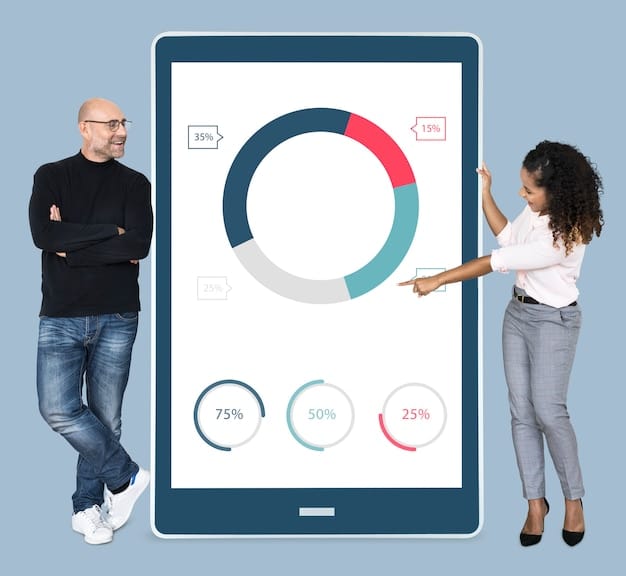Master the Envelope System: Your Budgeting Guide for 2025

The Envelope System is a time-tested budgeting method poised for a resurgence in 2025, allowing individuals to control their spending by allocating specific amounts of cash to various expense categories, fostering financial awareness and discipline.
Are you ready to take control of your finances and achieve your financial goals? The Envelope System is a proven budgeting method that’s making a comeback in 2025, offering a hands-on approach to managing your money effectively. It’s time to ditch the digital distractions and embrace a tangible strategy for financial success.
What is the Envelope System?
The Envelope System is a budgeting technique where you allocate a specific amount of cash for different spending categories each month. The idea is simple: once the cash in an envelope is gone, you can’t spend any more in that category until the next month.
This hands-on approach forces you to be mindful of your spending habits, making it easier to stay within your budget and achieve your financial goals. It’s a practical way to visualize your spending and avoid overspending.
Origins and Evolution
The Envelope System isn’t new. It’s been around for decades, predating the rise of credit cards and digital banking. Initially, it was a way for households to manage their finances when cash was king.
While digital budgeting tools have gained popularity, the Envelope System remains relevant because it provides a tangible connection to your money, making budgeting more personal and effective.
Why Use the Envelope System in 2025?
In an increasingly digital world, the Envelope System offers a refreshing alternative to impersonal budgeting apps and automated spending. Here are a few reasons to consider it:
- Greater Awareness: Handling physical cash makes you more aware of how much you’re spending.
- Debt Reduction: By sticking to your budget, you can avoid accumulating debt.
- Financial Control: The system gives you a clear sense of where your money is going.
- Behavior Modification: The tangible nature of cash can help curb impulsive spending.
Using the Envelope System in 2025 is about consciously choosing a method that promotes financial mindfulness and discipline.
Setting Up Your Envelope System
Creating your own Envelope System is straightforward. It involves identifying your spending categories, allocating funds, and tracking your expenses. Here’s how to get started:
Take the time to set up your system thoughtfully. The clearer and more organized it is, the more effective it will be in helping you manage your finances.
Identify Your Spending Categories
Start by making a list of all your monthly expenses. These could include:
- Groceries
- Rent or Mortgage
- Utilities
- Transportation
- Entertainment
Allocate Funds
Determine how much money you want to allocate to each category. Review your past spending and adjust amounts based on your financial goals. Be realistic, but also aim to reduce unnecessary expenses.
For example, if you typically spend $500 on groceries each month, but you want to cut back, consider allocating $400 and challenging yourself to stay within that limit.
Prepare Your Envelopes
Label each envelope with a spending category. Use physical envelopes or a designated wallet with separate compartments. The key is to keep it organized and easily accessible.
You might even consider using different colored envelopes for different types of expenses to make it easier to distinguish between them at a glance.

Pros and Cons of the Envelope System
Like any budgeting method, the Envelope System has its advantages and disadvantages. Understanding these can help you decide if it’s the right approach for you.
While the Envelope System may not be perfect for everyone, it offers unique benefits that are hard to replicate with digital tools alone.
Advantages of the Envelope System
- Promotes Awareness: Seeing and handling cash makes you more aware of your spending habits.
- Prevents Overspending: Once an envelope is empty, you can’t spend any more in that category.
- Reduces Debt: By sticking to your budget, you can avoid accumulating credit card debt.
- Simple and Tangible: The system is easy to understand and implement, offering a physical connection to your money.
Disadvantages of the Envelope System
While the benefits are substantial, there are also some drawbacks to consider:
- Inconvenience: Carrying cash can be less convenient than using credit cards.
- Risk of Loss or Theft: Cash can be lost or stolen, which is a significant risk.
- Limited Applicability: Some expenses, like online bills, are difficult to pay with cash.
- Tracking Challenges: Keeping track of every transaction can be time-consuming without digital tools.
Weigh the pros and cons carefully to determine if the Envelope System aligns with your lifestyle and financial goals. Some potential drawbacks, like the risk of loss or inconvenience, may be easily mitigated with a bit of extra planning, creative digital solutions, or simply prioritizing safety.
Adapting the Envelope System for 2025
While the basic principles of the Envelope System remain the same, you can adapt it for 2025 by incorporating digital tools and strategies to overcome its limitations.
Blending traditional methods with modern technology can create a powerful and personalized budgeting system that works for you.
Use Digital Trackers
While the Envelope System relies on cash, you can still use digital apps to track your spending. This can help you see where your money is going and identify areas where you can cut back.
Apps like Mint, YNAB (You Need A Budget), and Personal Capital allow you to categorize your expenses and monitor your progress. Even a simple spreadsheet can provide valuable insights.
Incorporate Virtual Envelopes
Consider using virtual envelopes for expenses that are difficult to pay with cash, such as online bills or subscriptions. Set up separate bank accounts or use a budgeting app with virtual envelope features.
This allows you to manage all your expenses within the Envelope System, even if some of them are paid digitally.
Automate Savings
Use automatic transfers to move money from your checking account to your savings account. This ensures that you’re saving consistently and reaching your financial goals.

Tips for Success with the Envelope System
To maximize your chances of success with the Envelope System, consider these practical tips:
By following these tips, you can optimize your Envelope System and achieve your financial goals.
Be Realistic
Set realistic budget amounts for each category. Don’t try to cut back too drastically, or you’ll be more likely to give up. Start with small changes and gradually adjust your budget as you become more comfortable.
Stay Organized
Keep your envelopes organized and easily accessible. Use a designated wallet or storage system to keep them in order. Regularly review your spending and adjust your budget as needed.
Be Consistent
Stick to your budget as closely as possible. Avoid dipping into other envelopes to cover overspending. If you find yourself consistently overspending in a particular category, re-evaluate your budget and make adjustments.
Track Your Progress
Regularly track your progress and celebrate your successes. This will help you stay motivated and committed to your financial goals. Consider rewarding yourself with small, budget-friendly treats when you reach milestones.
Common Pitfalls to Avoid
While the Envelope System can be highly effective, there are some common pitfalls to watch out for:
Avoiding these pitfalls can help you stay on track and maximize the benefits of the Envelope System.
Not Tracking Expenses
Failing to track your expenses can undermine the effectiveness of the Envelope System. Make sure to keep track of every transaction, even if it’s just a small purchase. This will help you identify areas where you’re overspending and make necessary adjustments.
Ignoring Irregular Expenses
Don’t forget to factor in irregular expenses, such as annual insurance premiums or holiday gifts. Set aside money each month to cover these expenses, so you’re not caught off guard when they come due.
Giving Up Too Easily
The Envelope System takes time and effort to implement successfully. Don’t get discouraged if you make mistakes or encounter challenges along the way. Learn from your experiences and keep refining your system until it works for you.
| Key Point | Brief Description |
|---|---|
| 💸 Budgeting | Allocate cash to different spending categories. |
| 🎯 Identify Goals | Prioritize financial goals and spending habits |
| 📱 Digital Adapt | Incorporate apps for tracking and virtual envelopes. |
| 🗓️ Be Consistent | Stick to your budget and track progress regularly. |
FAQ
▼
The system involves allocating specific amounts of cash to different spending categories. Once an envelope is empty, you can’t spend any more in that category until the next month.
▼
While it’s ideal for categories you can pay for with cash (like groceries or entertainment), adapt it for online bills using virtual envelopes or separate accounts.
▼
Create a “Contingency” envelope for those unexpected costs. If no money is left, see about borrowing from other envelopes, but paying back as quickly as possible.
▼
If you have money remaining, you can either roll it over to the next month, put it toward savings, or use it to pay down debt.
▼
Apps and spreadsheets will enable you to monitor all categories, including digital and cash spending, along with enabling virtual budgeting for those online expenses.
Conclusion
In 2025, the Envelope System remains a powerful tool for achieving financial control and awareness. By allocating cash to specific spending categories, you can take a hands-on approach to managing your money, reducing debt, and reaching your financial goals. Adapt the system to fit your lifestyle, incorporating digital tools to overcome its limitations and maximize its benefits.





